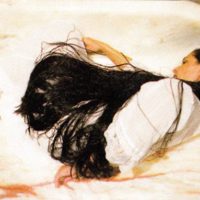bath’s house paço imperial, 2001
By Paulo Sérgio Duarte – The History of Angela Freiberger’s Marble
From the scene, only the furniture was left. An archaic memory of the statuary, which from its passage left light traces in the cold stone. The body that once marked the marble is now a ghost. She wanders in this chamber of the unconscious and needs the weight of the matter to announce her absence. She was freed by a bath, a plunge and then the sleep of Mabe, the faith. It purged all her sins in a purification act, and then went for a walk, a sleepwalk, in the vernissage, indifferent to the crowd that drunk and chatted. In the both, she did not look for innocence: she just wanted the lightness of movement and transferred to the static pieces all the rigidity and remembrance. She did not give them the monstrous scale of a Louise Bourgeois; she stayed in the Alentejo, working in a domestic dimension: for this reason, this familiar aspect, of an intimate poetry which delicately whispers a hand, an arm, a shoulder. The stones have the white light of dawn. She crossed the Atlantic in the company of the philosopher dancer, who she had, in a moment, transformed in to a photographer, and she returned to Brazil. She followed the way to “Alto do Boa Vista”, at the foot of the mountains of the city of the Saint martyr, whose body bleeds tied to the trunk, hit by his tormentors’ arrows, and she started to work in the industry amongst machines, dust and noise. From up there, if she focused well her eyes, beyond the sea, she would see Africa and the sacrifice of the king. But she does not want this immense ocean space and history because her emptiness is different. The one of the body that comes out, leaves in the sleep and opens doors to important events. But, when she wakes up, she only sees the marks in the marble – feet, hands, arms, shoulders, the remainders of the dream – and feels all the weight of forgetfulness of the stone. After the bath, the walk, she thought of a meal on immense plates where the food, invisible, would be placed outside them, on the table, around them and everybody would look only at the pale discs, absolutely plane and dull as absolute mirrors of nothing.
Paying attention, she saw that she had built a house, made of both and meal. Happy, in the bathtub, almost bed, she rests. And, again, she dreams of the next scene.
This is one of the many stories of Angela Freiberger’s marble, which is told there in Carrara, in Italy, land of people who, for centuries, have worked the stone. It can be told in many other ways. I know a critic who prefers to inscribe her in the repertoire of contemporary art and in her feminine side, in one of those interpretations which empties the art in question from the artistic question to transfer it to a multicultural level, where the contents replace all the question of form. But (he does not resist and talks about the viciousness of the red liquid (in fact red currant syrup solved in water), in which the artist bathes, as a metaphor for the sanguine, renaissance drawings which invented the female body in the sketches of the great artists who had never seen a naked woman. Or because they were not really interested in this kind of body. This is a possible trip. Another one, the strict formalist, who exalted in his theoretical repression, cannot see anything beyond o problem of bathroom decorator architect. In him, art is tied to a history of precise specific practices. Once the constructive and expressive paradigms have been reached no work escapes the dilemma: it either conforms or it is not form. There is still the historic researcher: this one verifies, certifies and puts into a frame, but does not pass judgment, because he is not a critic. And, above all, cannot talk about something that is so near, for he always needs distance. The most comic ones are those who are always making their “top ten lists”. For them it is difficult to understand the art of Angela, which is made of marble, video, performance and is more than these three media in which it materializes.
Paulo Sérgio Duarte translated by Hilda Maciel, Rio de Janeiro, october, 2001
